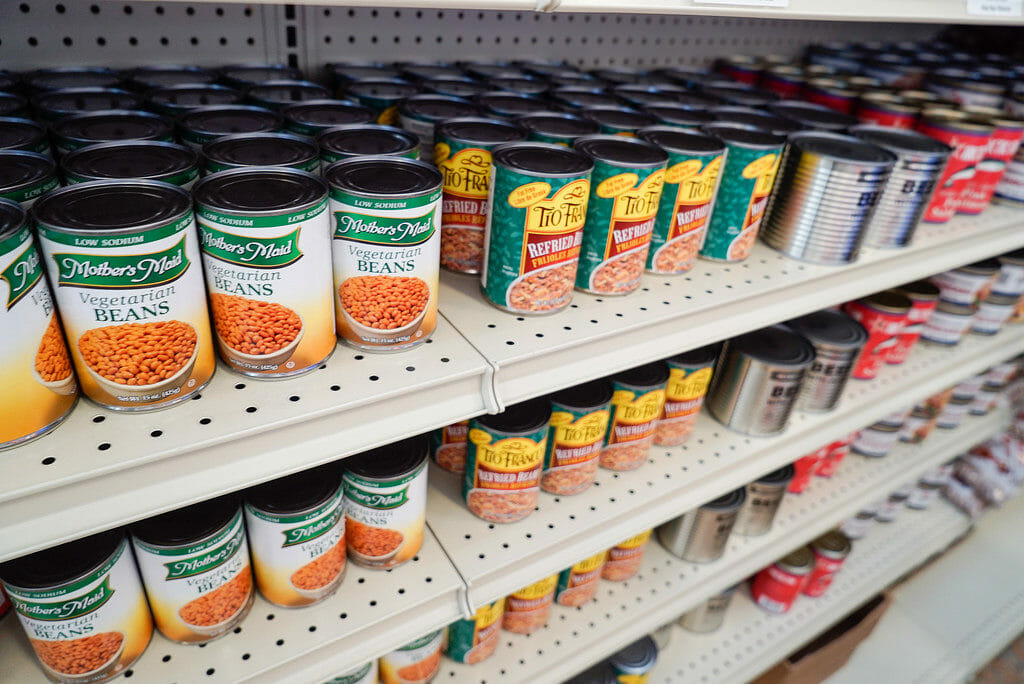Are you thinking about starting a food storage stockpile but you aren’t sure where to start? Do you want to stop stocking up on supplies – hurriedly — in advance of severe storms? Are you just beginning to store extra food, but you aren’t sure if you’re doing it right?
If so, then read on. We’ll tell you what to buy, how to get good deals, and ways to store extra food so you are prepared to shelter in place with plenty of supplies on hand.
Slow and Steady Wins the Race
How to best stockpile? Slowly and steadily is the best way to build a food supply. You don’t want the large expense and rush of trying to get everything at once. In addition, building a food supply gradually gives you the advantage of personalizing your plan, and adjusting for things you may have missed when you initially began.
How should you start the stockpile process? First, think about the meals you consistently prepare week in and week out. These meals and dishes are your mainstays, or simply the foods you and your family are accustomed to eating and that you know and like. When you are first beginning to stockpile, you should first stock up on these familiar ingredients to prepare your mainstay dishes. With a supply of these foods always on hand, you will be well-prepared in the event of a storm without having to make a rushed and crowded grocery run.
We’ll go into more detail about what exactly to buy below, but you should start by picking up a few items each week with your regular grocery runs. Initially, these extra items will be foods you already eat and like and use to prepare the mainstay dishes we talked about above. With a few items each week, you will build a supply of food that will last a week, and from there you can carefully and gradually double that to a two-week supply. Once you have a two-week supply of food, you will repeat the process until you again double and have enough of a supply to last a month, then two or three months. Step by step, week by week, you will gradually accumulate a stockpile to tide you through potential shortages.
Don’t Put all Your Eggs in one Basket (Diversify)
You might see suggestions to stock up on one item at a time; for example, to start with water and to stockpile only water until you have your supply of water all stored. This sounds efficient and well-planned, but it is not ideal at all. What if a situation occurs before your stockpile is finished? You might have plenty of water or flour, but not much else. It is better to buy a few different items at one time. Do not stockpile “one item at a time.” Instead, buy several different things: a jug or two of water, a jar of peanut butter, and then a mainstay dish ingredient or two.
Just 30 Grams Of This Superfood Provides More Nutrition Than An Entire Meal!
Water can be tricky to store. Evaluate whether you have a dependable source of water, and if you don’t, you will have to stockpile water in containers, and/or water filtration or treatments to make water from natural sources drinkable or potable (drinking untreated water from a river or a stream can make you seriously ill).
Practice Makes Perfect: Use Your Stockpile
Yes, we really mean it: You need to use your stockpile. It might go against your instincts, but incorporating your stockpile into your meal preparation is important because when you eventually build a longer-term stockpile, you will go shopping to replenish your stockpile, not your cupboards. Why? All foods have a shelf life, and many have an expiration date. If you don’t use the items from your stockpile, it will (at some point) age past the point of use. You don’t want a stockpile of expired or ancient food. By incorporating items from your stockpile into your daily or weekly meals, you will keep the items in your supply fresh. This is known as “rotating” your stockpile — pulling older items out for use, and then shopping to replenish them. This is also why you should take a close look at whether MRE (meals ready to eat) rations and types of stockpiles really suit your purposes. They do expire, and unless you actually use them on a regular basis, you may find yourself one day with very expensive and totally inedible food.
As you use your stockpile and replenish it, take notes of items you are using the most to prepare meals. If there are items you use that you are not yet stockpiling, then add those items to the extras you pick up on your grocery runs.
What to Buy
As mentioned above, focus first on the ingredients needed to prepare your mainstay dishes, plus water. Other good staples to consider are:
- Grains such as pasta, rice, & oatmeal
- Peanut butter
- Crackers
- Cereal
- Nuts and trail mix or granola bars/power bars
- Dried fruit
- Tuna fish
- Canned soups
- Canned vegetables
- Vinegar, oil, mayonnaise, salt, seasonings
- Water in containers and/or water treatments
Also, consider paper goods, food packaging, garbage bags, dish soap, personal toiletries and an upgraded first-aid kit and offline reference materials and skills.
How do you get the best deals? Conserving resources is important, so try to shop any deals that you spot. If there’s a sale on items you regularly use, then pick up one or two extra for your stockpiled food supply. Research whether coupons or buying in bulk for some items makes sense for your particular situation. Break down the cost per item by dividing the total price by the number of items to see if you are actually getting a deal buying a larger quantity.
Ways to Store Extra Food
The trick is to have your stockpile easily accessible so you can rotate items. You also need to protect your stockpile from pests, temperature extremes and humidity. Many people find that the basement or cellar is an ideal spot for stockpiling, using shelves or airtight and waterproof packaging (5-gallon buckets, jars, metal trash cans lined with food safe bags).
You also can add space to your cupboards by getting risers to create another level inside the cupboard, or racks to store items behind the cupboard door itself (take time to make sure your cabinets are securely fastened to the wall before adding the extra weight of canned goods). Consider extra unused or underutilized space in closets, under the bed, or in the back of deep kitchen cupboards. Are you storing empty suitcases? Why not fill those with food since they are taking up space anyway? Create shelving in odd spaces such as under stairs or above the clothes washer and dryer, or around the top edge of a garage wall.
So you see, it’s not hard to find and store items for your own stockpile. You can take the first steps to build a food stockpile easily and gradually during your weekly grocery shopping so that you can weather an emergency without having to make any runs to the grocery store.
What advice would you add? Share your tips in the section below:
 Off The Grid News Better Ideas For Off The Grid Living
Off The Grid News Better Ideas For Off The Grid Living





